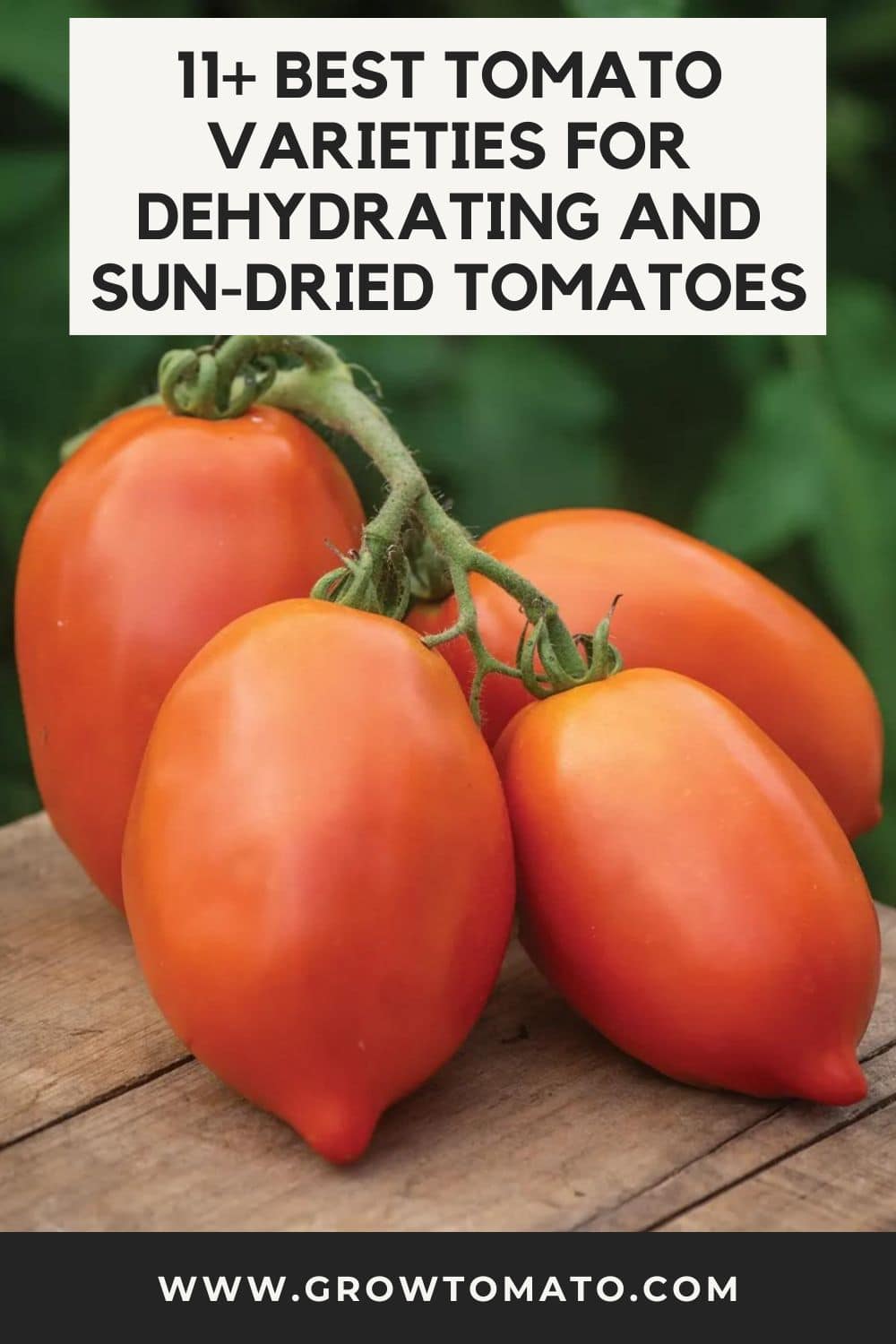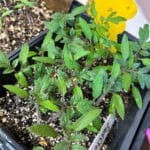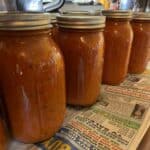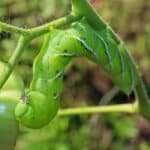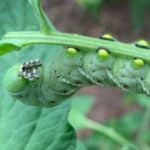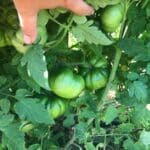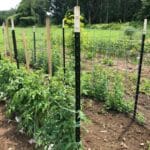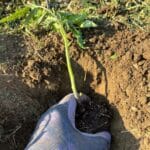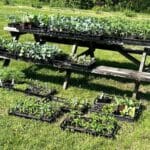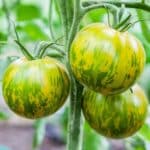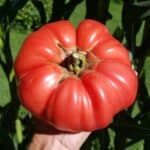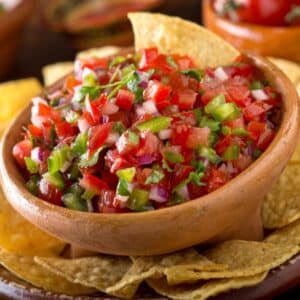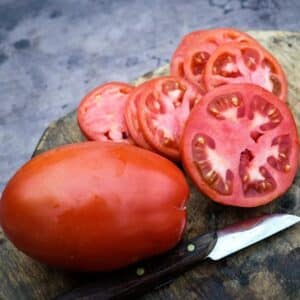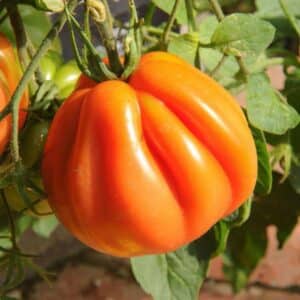The best types of tomatoes for dehydrating and sun drying are elongated, paste-type tomatoes. Plum tomatoes, Roma tomatoes, oval-shaped, and pear-shaped Italian tomatoes are the best for drying and dehydrating.

What makes these types of tomatoes best for drying is that they are meaty, have a low moisture content, and hold together well even when the flesh shrinks. They are also easy to peel, which is important if you like to peel your tomatoes before drying (optional).
Finally, plum and Italian-type tomatoes are firm enough for handling, slicing, and prepping without breaking or mushing. The structure is important when you’re making dried tomatoes and dehydrated tomato products. It is also important when you go to use the dried tomatoes or rehydrate them.
Round tomatoes, even those that are good for canning and saucing, are usually not the first choice for making dried tomatoes because they tend to have more seed cavities, and those tend to break apart with drying. Simply put, the more meat connecting the flesh of the tomato, the better it will withstand drying.
Italian-style/plum tomatoes also tend to have better flavor for dehydrating without becoming too overpowering when the tomatoes are dried and the flavor concentrates.
To sum it up, for dehydrating tomatoes and for making sun-dried tomatoes and dried tomato products, look for tomatoes that:
- Are elongated in shape
- Oval, pear-shaped tomatoes work well
- Plum tomatoes
- Italian tomatoes (mostly the long, not round/slicer varieties)
- Tomatoes with few seeds/small seed cavities (as flesh shrinks, seeds will take on more proportion, and seed cavities may break off if there are too many)
- Good, meaty flesh
- Typically, smaller-sized varieties do best (sweeter, less juice, easier to work with, few seeds)
- Low moisture content (speeds drying time and reduces utility usage; also decreases spoilage and molding because they dry faster)
- Firm enough to be peeled (if desired), chopped, sliced, prepped, etc.
- Fleshy enough to rehydrate
- Good flavor even without juice
- Sweetness and balance (acidic flavors can come off as bitter in dried tomatoes)
Jump to:
11 of the Best Tomatoes for Drying and Dehydrating
1. San Marzano
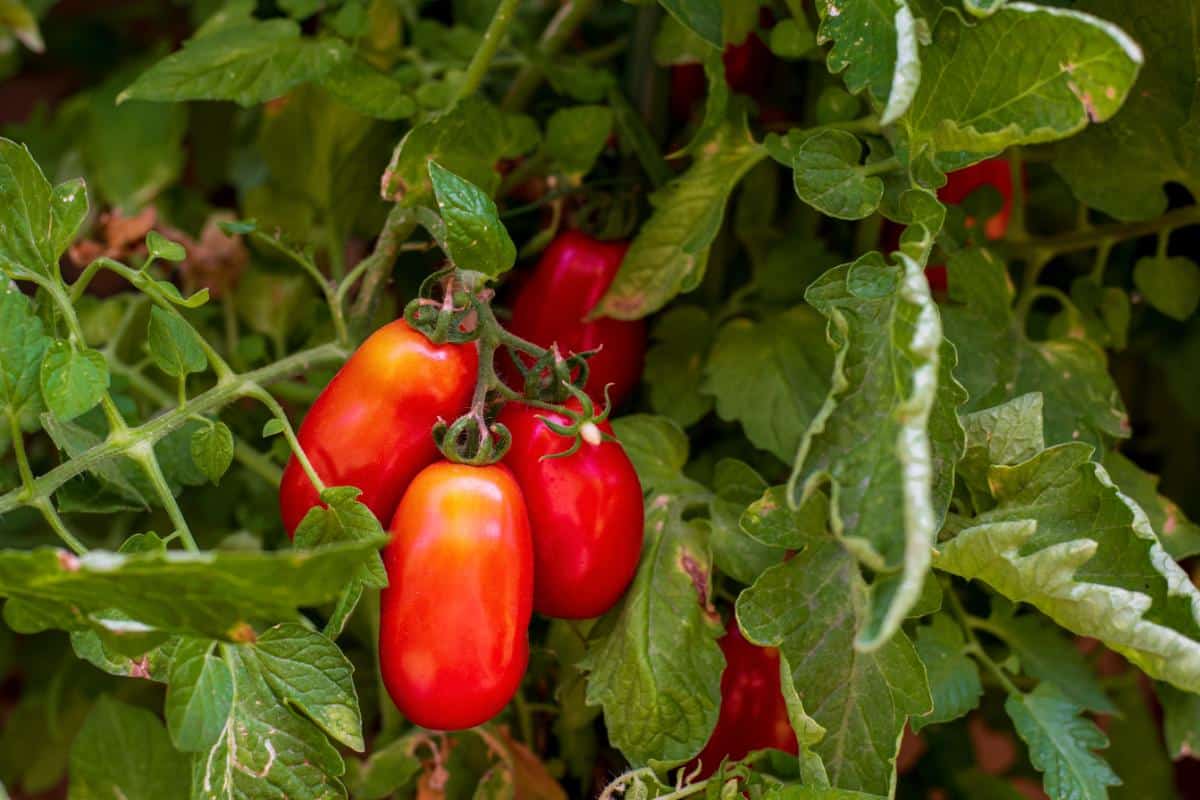
| Flavor: | Very good; classic Italian flavor |
| Type: | Italian canner |
| Color: | Red |
| Size: | 4 to 5 ounces |
| Uses: | Cooking, saucing, stewing, canning, dehydrating, sun drying, paste, salsa |
| Climate Notes: | Suitable for all climates |
| Disease Resistance: | Good; not specifically bred for resistance, but displays resistant tendencies |
| Growing Conditions: | Full sun, fertile soil, slightly acidic, needs support (stakes or cages, trellises) |
| Days to Harvest: | 80 days |
| Yield: | High |
| Determinate or Indeterminate? | Indeterminate |
Where to Buy San Marzano Tomato Seeds:
San Marzano is considered the tomato variety for making sun-dried tomatoes. This is the classic Italian tomato that traditional Italian sun-dried tomatoes are made from. The characteristics that make it good for sun drying make it excellent for any other type of dehydrated tomato product, too.
The tomatoes are meaty and have a lower moisture content that helps them to dry more quickly and more completely. They have few seeds, so the end result is a meaty dried tomato with only a few seeds.
2. Amish Paste

| Flavor: | Very good: sweet, meaty, juicy, classic tomato flavor |
| Type: | Multi-purpose paste/canning tomato |
| Color: | Red |
| Size: | 8 to 12 ounces (largest canning type) |
| Uses: | Multi-purpose; drying/dehydrating, canning, paste, sauces, soup, fresh eating, slicing, salads |
| Climate Notes: | Suitable for all regions, developed in the northern U.S. Midwest |
| Disease Resistance: | Good, not well documented, resilient from blight with treatment |
| Growing Conditions: | Full sun, fertile soil, slightly acidic, needs support (stakes or cages, trellising) |
| Days to Harvest: | 75 to 85 days |
| Yield: | High; continuous production through frost |
| Determinate or Indeterminate? | Indeterminate |
Where to Buy Amish Paste Tomato Seeds:
Amish Paste tomatoes are one of the best and hardiest heirloom paste tomatoes. The fruits are large, giving you lots of yields, and they maintain their traditional heirloom tomato flavor. There is plenty of meat and only a few seeds in these versatile, reliable performers. They are also coreless, which means you get no tough white parts in the middle of your dried tomato products and slices.
3. Roma/Roma VF
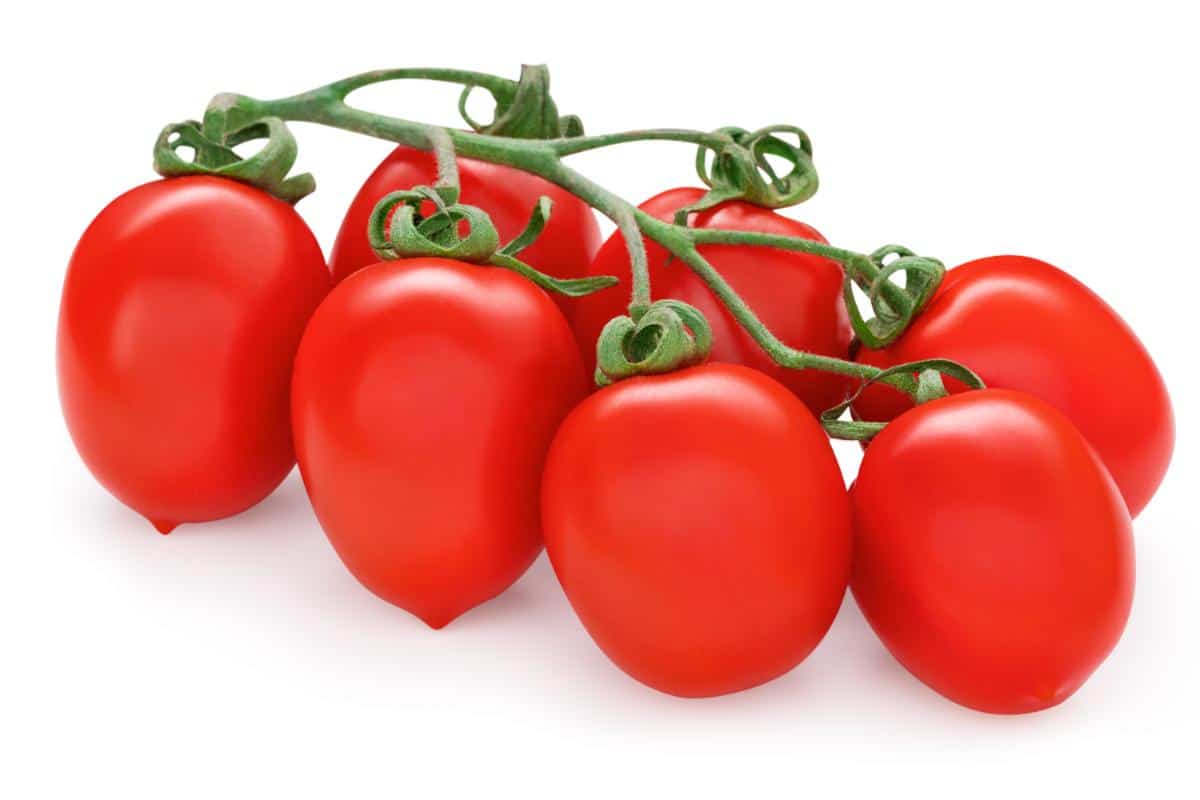
| Flavor: | Good; classic Italian tomato flavor |
| Type: | Canner, Roma, Plum |
| Color: | Pink-Red |
| Size: | 2 to 4 ounces |
| Uses: | Dehydrating, saucing, canning, cooking, juicing; good for fresh eating |
| Climate Notes: | Suited to growing in all climates; water deeply during dry weather |
| Disease Resistance: | Good: Verticillium wilt, Fusarium wilt |
| Growing Conditions: | Full sun, fertile soil, slightly acidic, needs support (stakes or cages) |
| Days to Harvest: | 76 to 78 days |
| Yield: | High |
| Determinate or Indeterminate? | Determinate |
Where to Buy Roma VF Tomato Seeds:
Roma tomatoes are another reliable Italian tomato that works well for all types of saucing, canning, and preserving, including drying and dehydrating. They’re a meaty fruit with few seeds in the typical plum shape. They’re small, so they only need to be cut in half to prep for drying, and they dry in a short time as compared to many larger, moister tomatoes.
The VF variety is a Roma with improved disease resistance.
4. Plum Regal
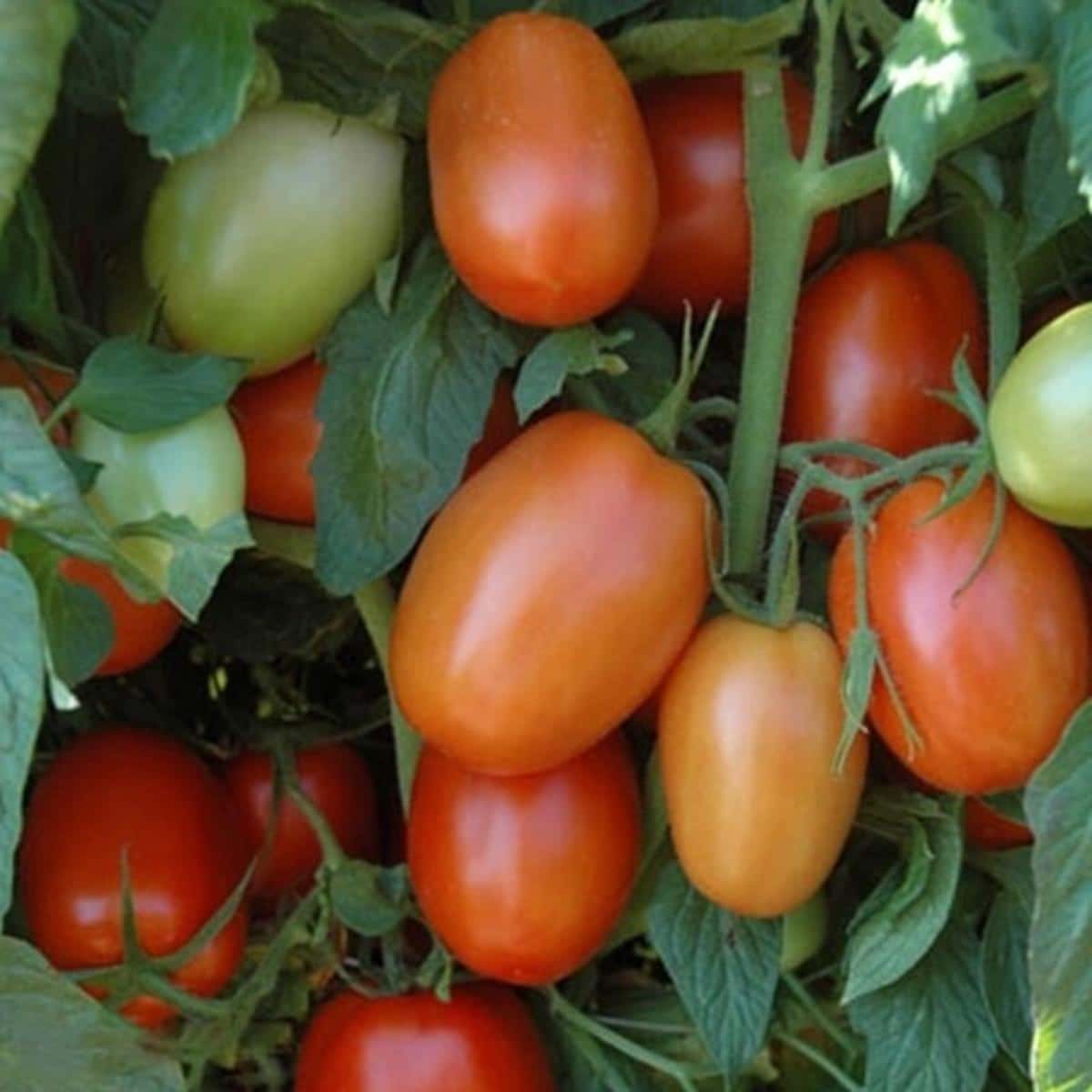
| Flavor: | Very good, well balanced, not bitter or overly sweet |
| Type: | Plum, canner |
| Color: | Red |
| Size: | 4 ounces |
| Uses: | Saucing, canning, dehydrating |
| Climate Notes: | Suited to all climates; not for short-season growers |
| Disease Resistance: | Excellent: Late blight resistant, moderate Early blight resistance, Fusarium wilt, Verticillium wilt, Tomato Spotted wilt virus |
| Growing Conditions: | Full sun, fertile soil, slightly acidic, needs support (stakes or cages) |
| Days to Harvest: | 75 days |
| Yield: | High |
| Determinate or Indeterminate? | Determinate |
Where to Buy Plum Regal Tomato Seeds:
Plum Regal is a blocky tomato with lots of solids. It is a hybrid, which gives it improved disease resistance, but it has not lost that lovely Italian tomato flavor. If you struggle to grow plum tomatoes that get hit by disease, Plum Regal is a variety you’ll want to consider.
Plum Regal can be slow to mature in extreme northern areas, so short-season growers may have difficulty getting these tomatoes across the finish line. Green tomatoes do ripen well off the plant, though.
5. Principe Borghese

| Flavor: | Very good, classic Italian |
| Type: | Small plum/grape |
| Color: | Red |
| Size: | 1 to 2 ounces |
| Uses: | Dehydrating, sun-dried tomatoes, sauces, paste, canning |
| Climate Notes: | Suited to all climates; don’t overwater; drought tolerant |
| Disease Resistance: | Good, crack resistant |
| Growing Conditions: | Full sun, fertile soil, slightly acidic, needs support (stakes or cages) |
| Days to Harvest: | 75 days |
| Yield: | High |
| Determinate or Indeterminate? | Determinate |
Where to Buy Principe Borghese Tomato Seeds:
Principe Borghese is another of the traditional Italian tomatoes that are used in Italy to make sun-dried tomatoes. These tomatoes are small, only one to two ounces, and they are a rounded plum shape with a pointed tip. Principe Borghese comes highly recommended for drying and dehydrating because the tomatoes are quite dry, have little juice and few seeds, and they’re meaty, too.
In Italy, they often cut the vines of ripe tomatoes and drape them over a fence to dry in the sun. This can work in dry climates, but if you experience a lot of humidity or heavy dew, you should consider a solar or electric dehydrator.
It is noted that you should not overwater these tomato plants, or the fruits become juicier, which is the opposite of what you want for dehydrating and sun drying.
6. Napoli
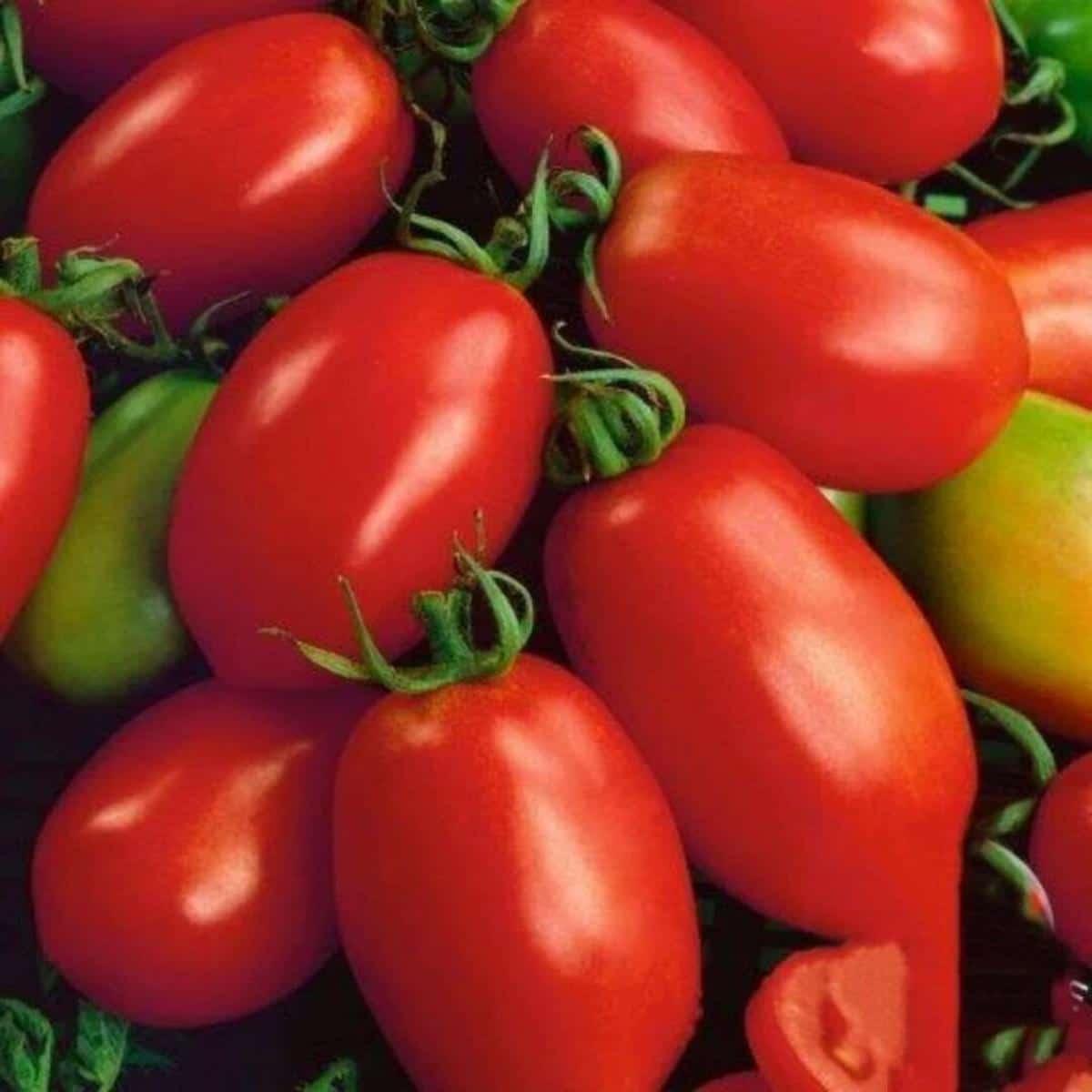
| Flavor: | Very good; sweet, Old world Italian |
| Type: | Plum |
| Color: | Red |
| Size: | 3 ounces |
| Uses: | Drying and dehydrating, all saucing, canning, preserving, juicing; fresh eating |
| Climate Notes: | Suited to all climates; Little Napoli is a good container choice |
| Disease Resistance: | Very good: Fusarium wilt, Verticillium wilt, Alternaria stem canker; crack resistant; resists blossom end rot |
| Growing Conditions: | Full sun, fertile soil, slightly acidic, needs support (stakes or cages) |
| Days to Harvest: | 75 days |
| Yield: | High |
| Determinate or Indeterminate? | Determinate |
Where to Buy Napoli Tomato Seeds:
- True Leaf Market
- Adaptive Seeds
- Urban Farmer
- Little Napoli: Territorial Seed
Napoli is favored for its sweet flavor and meatiness. It is a juicier tomato than a lot of the others on this list. Napoli is an old Italian variety that grows elongated pear-shaped tomatoes around three to six ounces, ideal for drying and dehydrating and good for all saucing, juicing, and canning projects. They do well as fresh-eating tomatoes, too.
There is a hybrid miniature version of Napoli called Little Napoli. These mature earlier, at 65 days, and are ideal for container growing if you want to make dried tomato products from container-grown plants. Little Napoli tops out between 24 and 36 inches and grows as a bush that doesn’t have to (but can be) staked.
7. Martino’s Roma
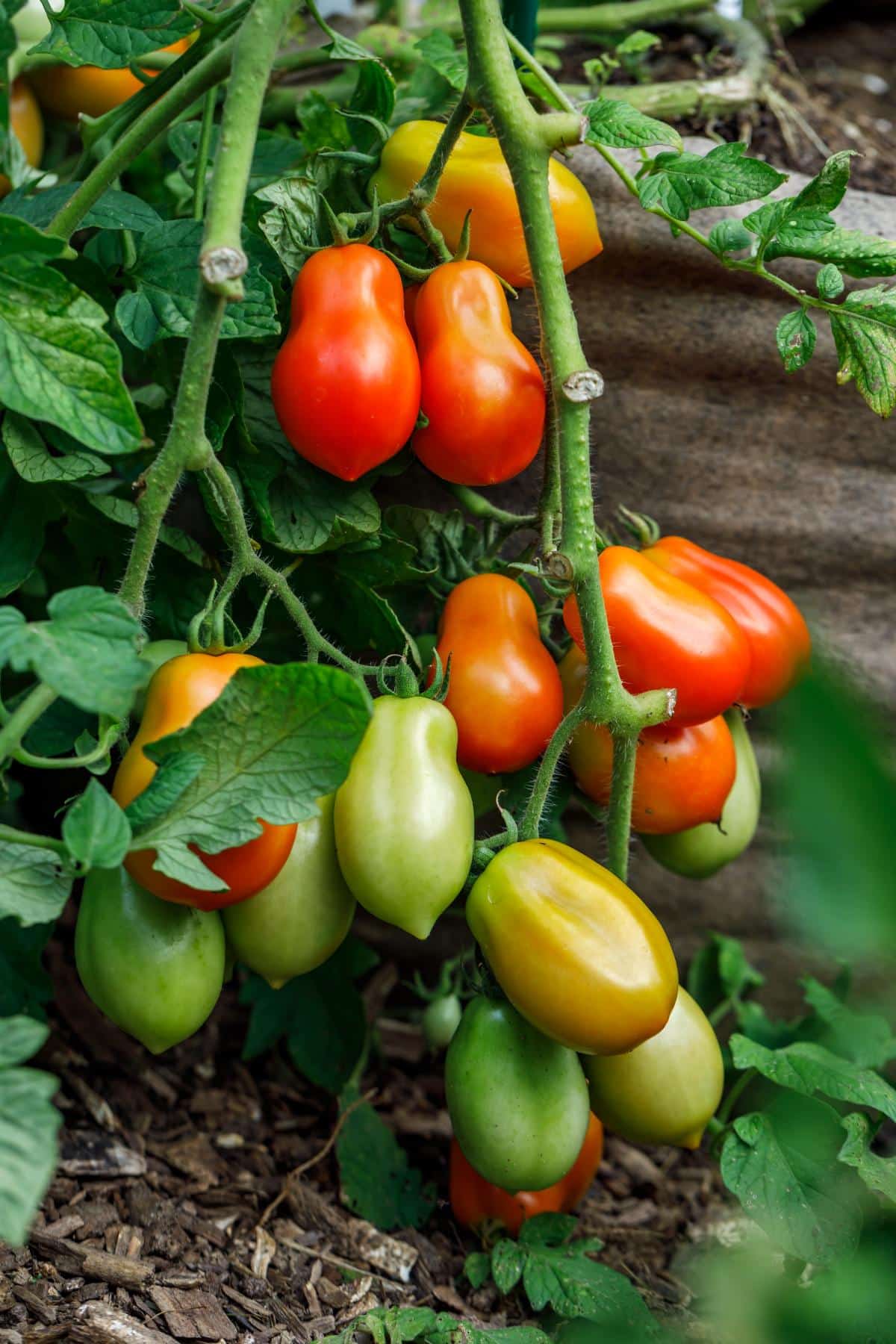
| Flavor: | Good |
| Type: | Plum |
| Color: | Red |
| Size: | 2 to 3 ounces |
| Uses: | Canning, cooking, saucing, dehydrating |
| Climate Notes: | Suited to all climates |
| Disease Resistance: | Good: Early Blight resistant |
| Growing Conditions: | Full sun, fertile soil, slightly acidic, needs only light support, if any |
| Days to Harvest: | 75 days |
| Yield: | High |
| Determinate or Indeterminate? | Determinate |
Where to Buy Tomato Seeds:
Martino’s Roma is an excellent choice for a container-grown tomato for dehydrating, drying, saucing, and canning. They work well in small spaces and raised beds, too.
The plants are small, topping out around three feet high, grow compactly, and don’t need much (if any) support.
Martino’s Roma is a determinate plant, and tomatoes grow in clusters that are easy to harvest. Three-ounce tomatoes are fleshy, dry, and have few seeds. One note about these tomatoes is that they do tend to fall off the vine if you leave them on for too long after ripening.
8. Yellow Pear
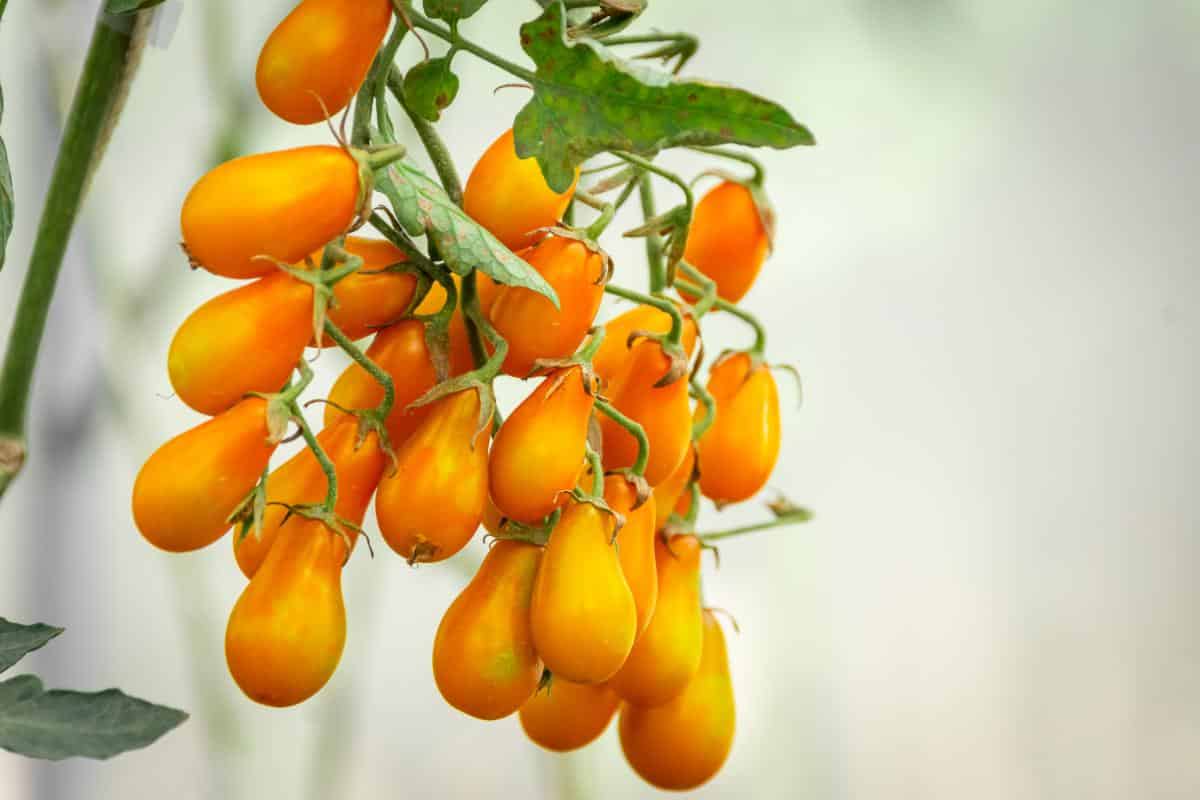
| Flavor: | Very good; mild, sweet |
| Type: | Small pear |
| Color: | Yellow |
| Size: | 2 to 4 ounces (1 ½”) |
| Uses: | Drying, dehydrating, Fresh salsa, fresh eating, salads, Hor d’oevres |
| Climate Notes: | Suited to all climates |
| Disease Resistance: | Very good: Late blight, Fusarium wilt, Verticillium wilt, Anthracnose |
| Growing Conditions: | Full sun, fertile soil, slightly acidic, needs support (stakes or cages) |
| Days to Harvest: | 75 to 80 days |
| Yield: | Very high |
| Determinate or Indeterminate? | Indeterminate |
Where to Buy Yellow Pear Tomato Seeds:
Yellow Pear tomatoes are known as a nice, sweet pear-shaped tomato that is excellent in preserves and salsa. Its small size makes it a good-drying tomato, too. This is a nice choice if you want to add some color to your dried tomato products and dishes.
The plants are known to be easy to grow and highly productive. The fruits themselves are small, but the plant produces many of them, so there is plenty to work with.
9. Big Mama
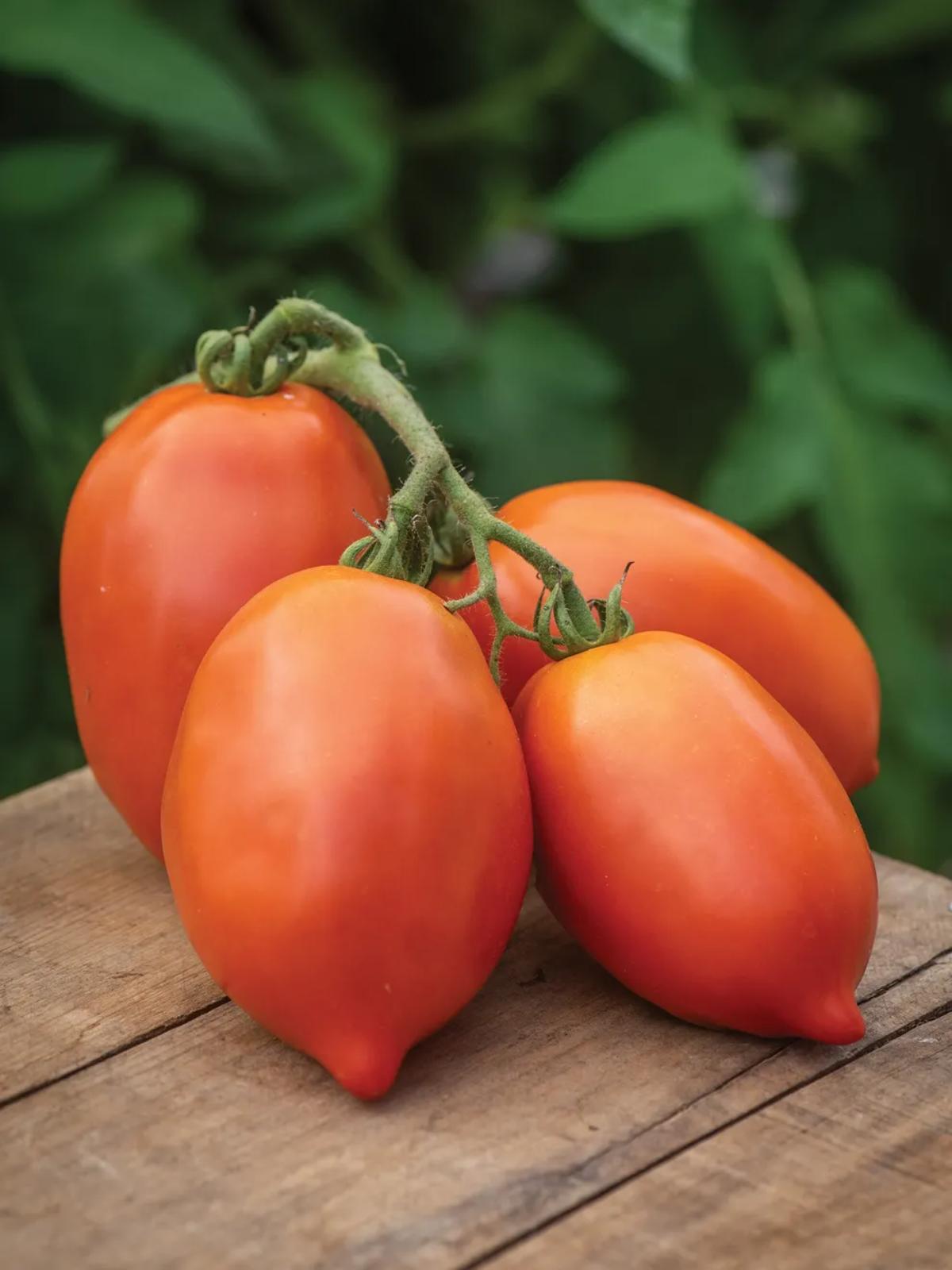
| Flavor: | Good |
| Type: | Paste/canning |
| Color: | Red |
| Size: | Large, 3”x5” |
| Uses: | Drying, dehydrating, canning, sauce, preserving, salsa |
| Climate Notes: | Suited to all climates |
| Disease Resistance: | Fair; not well documented |
| Growing Conditions: | Full sun, fertile soil, slightly acidic, needs support (stakes or cages) |
| Days to Harvest: | 80 days |
| Yield: | Very high |
| Determinate or Indeterminate? | Indeterminate |
Where to Buy Big Mama Tomato Seeds:
Big Mama is a hybrid, a large paste/plum tomato. Each one measures about 3” by 5”. They are all meat, so there’s plenty of yield, and you’ll have enough tomatoes from these plants to fill all your drying, preserving, saucing, and canning needs. Easy peeling and early ripening on indeterminate vines that keep on going all season long.
10. Federle

| Flavor: | Excellent; rich, balanced |
| Type: | Paste |
| Color: | Red |
| Size: | 7 inches |
| Uses: | Drying, dehydrating, paste, canning, sauce |
| Climate Notes: | Suited to all climates; originated in U.S. West Virginia; long maturity may be difficult for northern growers |
| Disease Resistance: | Fair; not well documented |
| Growing Conditions: | Full sun, fertile soil, slightly acidic, needs support (stakes or cages) |
| Days to Harvest: | 85 days |
| Yield: | High |
| Determinate or Indeterminate? | Indeterminate |
Where to Buy Federle Tomato Seeds:
Flavorful, long-paste tomatoes measuring up to 7 inches long, shaped similar to banana peppers. They're almost all meat with very few small seeds, and they are very dry tomatoes. The only drawback to Federle is that these tomatoes mature late, so they may prove difficult for more northerly growers and growers with short seasons.
11. Speckled Roman
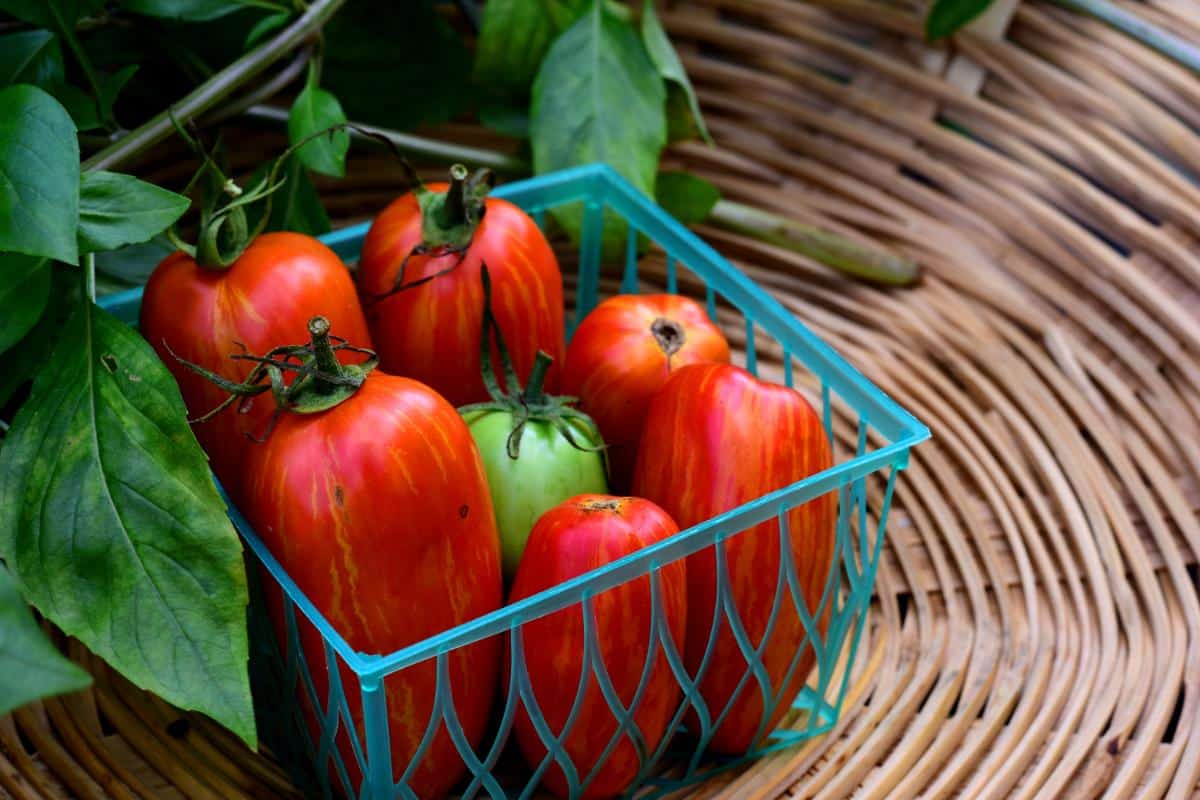
| Flavor: | Excellent |
| Type: | Paste |
| Color: | Red with Orange Stripes |
| Size: | 6 ounces |
| Uses: | Drying, dehydrating, canning, saucing, preserving |
| Climate Notes: | Suited to all climates; may experience disease in wet, cool locations |
| Disease Resistance: | Fair/Good: Few issues reported, but cold, wet seasons can cause disease |
| Growing Conditions: | Full sun, fertile soil, slightly acidic, needs support (stakes or cages) |
| Days to Harvest: | 80 to 85 days |
| Yield: | Very high |
| Determinate or Indeterminate? | Indeterminate |
Where to Buy Speckled Roman Tomato Seeds:
Speckled Roman is a large paste tomato with unique coloration and striping, red with orange stripes. If you want a delicious, high-yielding, but unique-looking tomato for your dehydrating and preserving projects, this is the one. The flesh is meaty red, and there is little juice or moisture, making it ideal for dehydrating. The flavor is excellent, good enough to eat fresh.
Pinetree Seed company says they’ve experienced a few disease issues with Speckled Roman, but Fedco Seeds notes that the tomatoes are prone to disease in cool, wet seasons, so disease resistance may depend on growing conditions.
Can Cherry Tomatoes Be Dehydrated?
The short answer? Yes. Cherry tomatoes can be dehydrated, too. However, it might be a stretch if we were to say they are the best tomatoes for dehydrating.
Still, because they grow so prolifically, people often have cherry tomatoes to spare, and they do make a good dehydrated product. Cherry tomatoes do best if they are cut in half before dehydrating and with the skins left on.
You may find that dehydrated cherry tomatoes are more seedy than dried plum and Italian types, but again, the sheer abundance of them makes up for the slightly diminished quality, and if you need to use up a bumper crop of cherry tomatoes, cutting them in halves and drying them is a good way to use them up.
As a rehydrated product/ingredient, cherry tomatoes often stand in well for diced tomatoes.
